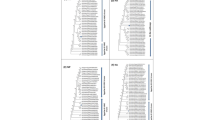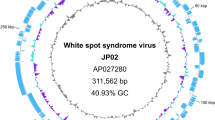Abstract
Classical swine fever (CSF) can run acute, chronic, and prenatal courses in both domestic pigs and wild boar. Although chronic infections are rare events, their epidemiological impact is very high due to the long-term shedding of virus. So far, little is known about the factors that influence disease course and outcome from either the host or virus’s perspective. To elucidate the viral determinants, we analyzed the role of the viral populations for the development of chronic CSF virus (CSFV) infections. Three different animal trials that had led to both chronic and acute infections were chosen for a detailed analysis by deep sequencing. The three inocula represented sub-genogroups 2.1 and 2.3, and two viruses were wild-type CSFV, one derived from an infectious cDNA clone. These viruses and samples derived from acutely and chronically infected animals were subjected to next-generation sequencing. Subsequently, the derived full-length genomes were compared at both the consensus and the quasispecies level. At consensus level, no differences were observed between the parental viruses and the viruses obtained from chronically infected animals. Despite a considerable level of variability at the quasispecies level, no indications were found for any predictive pattern with regard to the chronicity of the CSFV infections. While there might be no direct marker for chronicity, moderate virulence of some CSFV strains in itself seems to be a crucial prerequisite for the establishment of long-term infections which does not need further genetic adaption. Thus, general host and virus factors need further investigation.

Similar content being viewed by others
References
Bintintan I, Meyers G (2010) A New type of signal peptidase cleavage site identified in an RNA virus polyprotein. J Biol Chem 285:8572–8584
Rümenapf T, Meyers G, Stark R, Thiel HJ (1991) Molecular characterization of hog cholera virus. Arch Virol Suppl 3:7–18
Lattwein E, Klemens O, Schwindt S, Becher P, Tautz N (2012) Pestivirus virion morphogenesis in the absence of uncleaved nonstructural protein 2-3. J virol 86:427–437
Meyers G, Thiel HJ (1996) Molecular characterization of pestiviruses. Adv Virus Res 47:53–118
Tratschin JD, Moser C, Ruggli N, Hofmann MA (1998) Classical swine fever virus leader proteinase Npro Is not required for viral replication in cell culture. J Virol 72:7681–7684
Postel A, Schmeiser S, Perera CL, Rodriguez LJ, Frias-Lepoureau MT, Becher P (2013) Classical swine fever virus isolates from Cuba form a new subgenotype 1.4. Vet Microbiol 161:334–338
Greiser-Wilke I, Depner K, Fritzemeier J, Haas L, Moennig V (1998) Application of a computer program for genetic typing of classical swine fever virus isolates from Germany. J Virol Methods 75:141–150
Paton DJ, McGoldrick A, Greiser-Wilke I, Parchariyanon S, Song JY, Liou PP, Stadejek T, Lowings JP, Björklund H, Belák S (2000) Genetic typing of classical swine fever virus. Vet Microbiol 73:137–157
Beer M, Goller KV, Staubach C, Blome S (2015) Genetic variability and distribution of Classical swine fever virus. Anim Health Res Rev 16:33–39
Moennig V, Floegel-Niesmann G, Greiser-Wilke I (2003) Clinical signs and epidemiology of classical swine fever: a review of new knowledge. Vet J 165:11–20
Dahle J, Liess B (1992) A review on classical swine fever infections in pigs: epizootiology, clinical disease and pathology. Comp Immunol Microbiol Infect Dis 15:203–211
Munoz-Gonzalez S, Perez-Simo M, Munoz M, Bohorquez JA, Rosell R, Summerfield A, Domingo M, Ruggli N, Ganges L (2015) Efficacy of a live attenuated vaccine in classical swine fever virus postnatally persistently infected pigs. Vet Res 46:78
Munoz-Gonzalez S, Ruggli N, Rosell R, Perez LJ, Frias-Leuporeau MT, Fraile L, Montoya M, Cordoba L, Domingo M, Ehrensperger F, Summerfield A, Ganges L (2015) Postnatal persistent infection with classical Swine Fever virus and its immunological implications. PLoS One 10:e0125692
Hulst M, Loeffen W, Weesendorp E (2013) Pathway analysis in blood cells of pigs infected with classical swine fever virus: comparison of pigs that develop a chronic form of infection or recover. Arch Virol 158:325–339
Collins ME, Desport M, Brownlie J (1999) Bovine viral diarrhea virus quasispecies during persistent infection. Virology 259:85–98
Dow N, Chernick A, Orsel K, van Marle G, van der Meer F (2015) Genetic variability of bovine viral diarrhea virus and evidence for a possible genetic bottleneck during vertical transmission in persistently infected cattle. PLoS One 10:e0131972
Ridpath JF, Bayles DO, Neill JD, Falkenberg SM, Bauermann FV, Holler L, Braun LJ, Young DB, Kane SE, Chase CC (2015) Comparison of the breadth and complexity of bovine viral diarrhea (BVDV) populations circulating in 34 persistently infected cattle generated in one outbreak. Virology 485:297–304
Petrov A, Blohm U, Beer M, Pietschmann J, Blome S (2014) Comparative analyses of host responses upon infection with moderately virulent classical swine fever virus in domestic pigs and wild boar. Virol J 11:134
Gallei A, Blome S, Gilgenbach S, Tautz N, Moennig V, Becher P (2008) Cytopathogenicity of classical Swine Fever virus correlates with attenuation in the natural host. J Virol 82:9717–9729
Blome S, Gabriel C, Schmeiser S, Meyer D, Meindl-Böhmer A, Koenen F, Beer M (2014) Efficacy of marker vaccine candidate CP7_E2alf against challenge with classical swine fever virus isolates of different genotypes. Vet Microbiol 169:8–17
David D, Edri N, Yakobson BA, Bombarov V, King R, Davidson I, Pozzi P, Hadani Y, Bellaiche M, Schmeiser S, Perl S (2011) Emergence of classical swine fever virus in Israel in 2009. Vet J 190:e146–149
Becker N, Jöst H, Ziegler U, Eiden M, Höper D, Emmerich P, Fichet-Calvet E, Ehichioya DU, Czajka C, Gabriel M, Hoffmann B, Beer M, Tenner-Racz K, Racz P, Günther S, Wink M, Bosch S, Konrad A, Pfeffer M, Groschup MH, Schmidt-Chanasit J (2012) Epizootic emergence of Usutu virus in wild and captive birds in Germany. PLoS One 7:e32604–e32604
Juozapaitis M, Moreira É, Mena I, Giese S, Riegger D, Pohlmann A, Höper D, Zimmer G, Beer M, García-Sastre A, Schwemmle M (2014) An infectious bat-derived chimeric influenza virus harbouring the entry machinery of an influenza A virus. Nat Commun 5:4448
Leifer I, Hoffmann B, Hoper D, Bruun Rasmussen T, Blome S, Strebelow G, Horeth-Bontgen D, Staubach C, Beer M (2010) Molecular epidemiology of current classical swine fever virus isolates of wild boar in Germany. J General Virol 91:2687–2697
Katoh K, Misawa K, Kuma K, Miyata T (2002) MAFFT: a novel method for rapid multiple sequence alignment based on fast Fourier transform. Nucleic Acids Res 30:3059–3066
Watson SJ, Welkers MR, Depledge DP, Coulter E, Breuer JM, de Jong MD, Kellam P (2013) Viral population analysis and minority-variant detection using short read next-generation sequencing. Philos Trans R Soc Lond Ser B Biol Sci 368:20120205
Höper D, Freuling CM, Müller T, Hanke D, von Messling V, Duchow K, Beer M, Mettenleiter TC (2015) High definition viral vaccine strain identity and stability testing using full-genome population data—the next generation of vaccine quality control. Vaccine 33:5829–5837
R Development Core Team (2014) R: a language and environment for statistical computing, 3.1.0 ed. R Foundation for Statistical Computing, Vienna, Austria
Hulst MM, van Gennip HG, Moormann RJ (2000) Passage of classical swine fever virus in cultured swine kidney cells selects virus variants that bind to heparan sulfate due to a single amino acid change in envelope protein Erns. J Virol 74:9553–9561
Morelli MJ, Wright CF, Knowles NJ, Juleff N, Paton DJ, King DP, Haydon DT (2013) Evolution of foot-and-mouth disease virus intra-sample sequence diversity during serial transmission in bovine hosts. Vet Res 44:12
Lange M, Kramer-Schadt S, Blome S, Beer M, Thulke HH (2012) Disease severity declines over time after a wild boar population has been affected by classical swine fever—legend or actual epidemiological process? Prev Vet Med 106:185–195
Goller KV, Gabriel C, Le Dimna M, Le Potier M-F, Rossi S, Staubach C, Merboth M, Beer M, Blome S (2015) Evolution and molecular epidemiology of Classical swine fever virus during a multi-annual outbreak among European wild boar. J General Virol (Epub ahead of print)
Dräger C, Beer M, Blome S (2015) Porcine complement regulatory protein CD46 and heparan sulfates are the major factors for classical swine fever virus attachment in vitro. Arch Virol 160:739–746
Dräger C, Petrov A, Beer M, Teifke JP, Blome S (2015) Classical swine fever virus marker vaccine strain CP7_E2alf: Shedding and dissemination studies in boars. Vaccine 33:3100–3103
Topfer A, Hoper D, Blome S, Beer M, Beerenwinkel N, Ruggli N, Leifer I (2013) Sequencing approach to analyze the role of quasispecies for classical swine fever. Virology 438:14–19
Bordería AV, Isakov O, Moratorio G, Henningsson R, Agüera-González S, Organtini L, Gnädig NF, Blanc H, Alcover A, Hafenstein S, Fontes M, Shomron N, Vignuzzi M (2015) Group selection and contribution of minority variants during virus adaptation determines virus fitness and phenotype. PLoS Pathog 11:e1004838
Fahnøe U, Pedersen AG, Dräger C, Orton RJ, Blome S, Höper D, Beer M, Rasmussen TB (2015) Creation of functional viruses from non-functional cDNA clones obtained from an RNA virus population by the use of ancestral reconstruction. PLoS One 10:e0140912
Fahnøe U, Pedersen AG, Risager PC, Nielsen J, Belsham GJ, Höper D, Beer M, Rasmussen TB (2014) Rescue of the highly virulent classical swine fever virus strain “Koslov” from cloned cDNA and first insights into genome variations relevant for virulence. Virology 468–470:379–387
Acknowledgements
We thank Moctezuma Reimann and Patrick Zitzow for technical assistance. This study was supported by the EMIDA ERA-NET project “Molecular Epidemiology of Epizootic Diseases using Next Generation Sequencing Technology (Epi-SEQ)” (Grant 2811ERA094).
Author information
Authors and Affiliations
Corresponding author
Ethics declarations
Conflict of interest
The authors declare that they have no conflicts of interest.
Electronic supplementary material
Below is the link to the electronic supplementary material.
Rights and permissions
About this article
Cite this article
Jenckel, M., Blome, S., Beer, M. et al. Quasispecies composition and diversity do not reveal any predictors for chronic classical swine fever virus infection. Arch Virol 162, 775–786 (2017). https://doi.org/10.1007/s00705-016-3161-8
Received:
Accepted:
Published:
Issue Date:
DOI: https://doi.org/10.1007/s00705-016-3161-8




